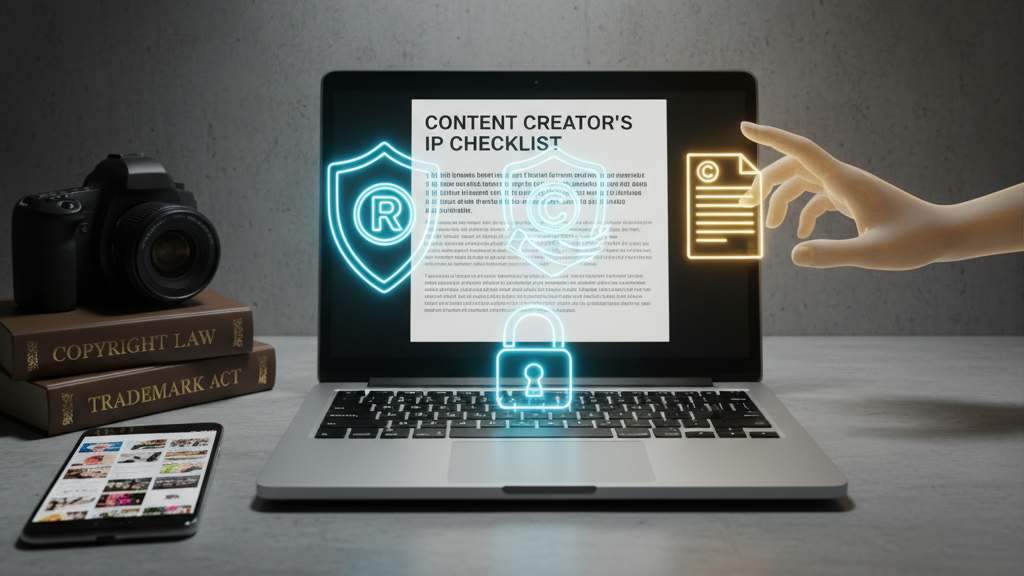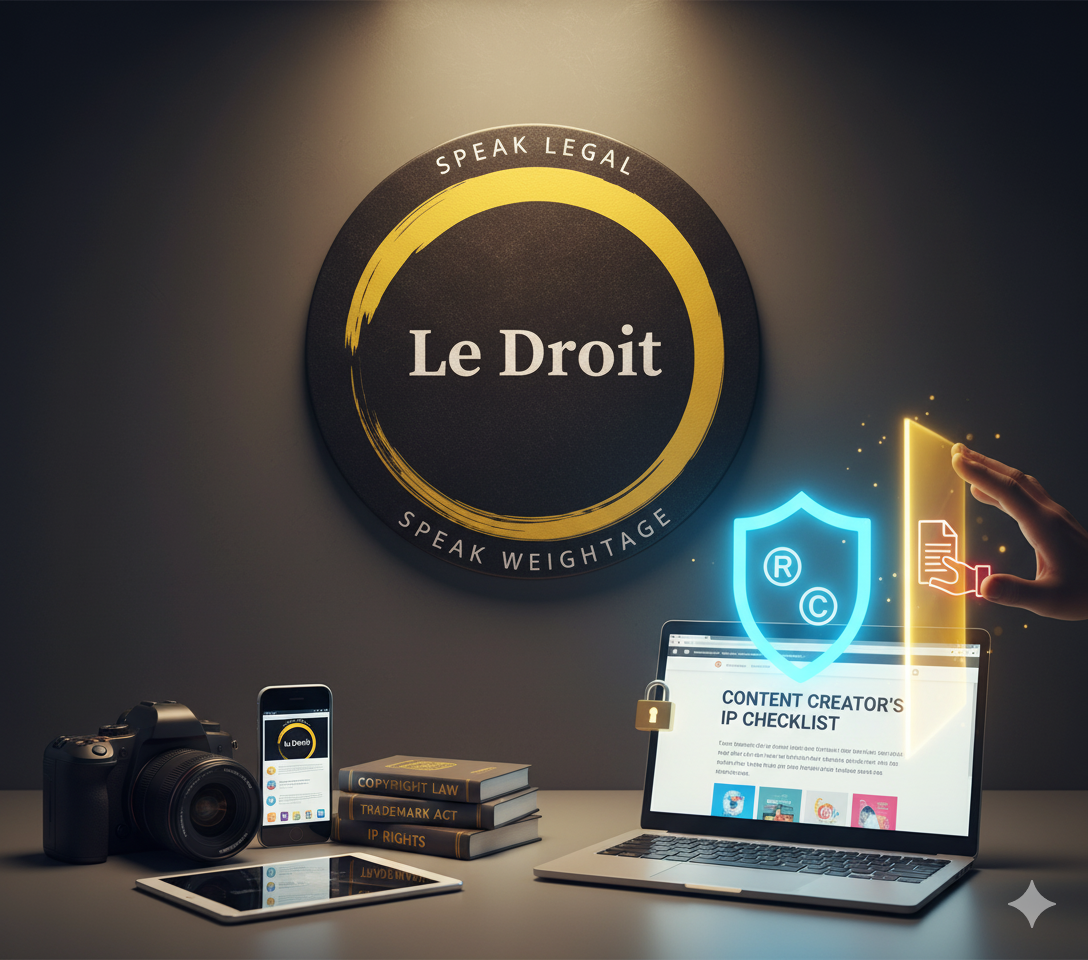
This article is written by Kimaya Anavkar, a T.Y.LL.B. student at Kishinchand chellaram Law College.
ABSTRACT
For today’s content creators, a clear understanding of intellectual property (IP) is essential for building a lasting career. India’s Copyright Act, 1957, automatically protects the online content you produce, making every piece a valuable asset. This guide provides a detailed roadmap for protecting your digital creations. We will explore the nuances of copyright protection, the specific steps for combating infringement, the complex realities of using third-party material under licensing and “fair dealing,” and the strategic importance of securing your brand with a registered trademark. By mastering your IP rights, you can confidently protect your work, unlock new revenue streams, and transform your creative passion into a well-defended enterprise.
Keywords: Intellectual Property, Content Creators, Copyright, Trademark, Fair Dealing, Online Content, Influencer IP, Copyright Act 1957.
CREATOR AS IP OWNER
Why Your Online Content is Valuable Intellectual Property
In the digital economy, your creative output is your inventory. It’s essential to shift your mindset from being just a creator to being the owner of a portfolio of valuable assets. Each piece of online content is a form of intellectual property with tangible value that extends far beyond likes and shares. Your IP is a monetizable asset.
For example:
- A stunning travel photograph you posted on Instagram could be licensed to a travel magazine or an advertising agency.
- A well-researched blog post could become the basis for a published book.
- Your original background music from a YouTube video could be licensed to other creators.
Understanding that you are an IP owner is the foundational step. It empowers you to control how your work is used, prevent unauthorized duplication, and build a brand that is legally and financially secure.
COPYRIGHT 101 EXPLAINED
What to Do if Someone Steals Your Content
Copyright is the bedrock of protection for content creators. Under the Copyright Act, 1957, your work is protected the moment it is created and “fixed in a tangible medium.” This means an idea for a video is not protected, but the moment you record that video and save the .mp4 file, it’s copyrighted.
- Originality is Key: The work must be original, meaning it originates from you and is not a copy of another work. It doesn’t have to be a masterpiece, just the product of your own skill and labor.
- What is NOT Protected: Copyright does not protect ideas, facts, procedures, titles, or short phrases. You can’t copyright the idea of a “Top 10 Gadgets of 2025” video, but you can copyright your specific video expressing that idea—your script, your visuals, and your editing.
A Step-by-Step Guide to Combating Infringement:
- Platform Takedown Notices (DMCA/Copyright Complaint): This is your fastest option. All major platforms have dedicated forms to report copyright infringement. You will need to provide:
- A link to your original work.
- A link to the infringing content.
- Your contact information.
- A sworn statement that you are the copyright owner.
- Cease and Desist Notice: For more direct action, a lawyer can draft a formal “Cease and Desist” letter. This legal notice is sent directly to the infringer, demanding they stop using your work and warning of potential legal action.
- Copyright Registration: While copyright protection is automatic, registering your work with the Copyright Office of the Government of India is highly recommended. Registration provides a public record of ownership and serves as strong evidence in a court of law, making it much easier to sue for damages.
USING OTHERS’ CONTENT
Navigating the Trap of Copyrighted Music, Memes, and Clips
Using third-party content is the single most common legal mistake creators make. Here’s how to navigate it safely.
The Safe Route: Understanding Licenses A license is formal permission from the copyright owner. It’s not as complicated as it sounds.
- Royalty-Free Licenses: This is the most popular model. You pay a one-time fee or a subscription to a service (like Epidemic Sound or Artlist), and get the right to use their music or video clips across multiple projects without paying royalties for each view.
- Creative Commons (CC) Licenses: This is often a “free” license, but it comes with specific conditions. Some CC licenses require you to only use the work for non-commercial purposes, while others require you to give attribution (credit) in a specific way. Always check the terms.
The Risky Route: “Fair Dealing” in India “Fair Dealing” is a provision under Section 52 of the Copyright Act, 1957, that allows for limited use of copyrighted material without permission for specific purposes, such as:
- Criticism or review (e.g., using movie clips in your review video).
- Reporting of current events.
- Private, personal use, including research.
However, the use must be “fair.” Courts determine fairness on a case-by-case basis, considering factors like the purpose of the use, the amount of the work used, and whether your use harms the original work’s market value. Relying on fair dealing is a significant legal risk; it is a defense you can use in court, not a right you can claim beforehand. When in doubt, always opt for licensed content.
TRADEMARKING YOUR BRAND
Why Your Channel Name and Logo Need Protection
As your audience grows, your brand identity becomes as valuable as your content. This is where trademark law, governed by The Trade Marks Act, 1999 in India, becomes critical.
Copyright vs. Trademark: An Example Imagine a popular cooking channel called “Spice Route with Chef Rohan” and a signature logo.
- Copyright protects the content: the recipes as written, the cooking videos, and the food photographs.
- Trademark protects the brand: the name “Spice Route with Chef Rohan,” the logo, and any unique catchphrases he uses, like “Taste the Tradition!”
The Power of a Registered Trademark: Registering your brand name and/or logo with the Trade Marks Registry of India gives you powerful protections:
- Nationwide Exclusivity: It provides the exclusive right to use that mark across India in connection with your services.
- The ® Symbol: You can legally use the ® symbol, which acts as a strong deterrent to potential infringers.
- Stronger Legal Recourse: Registration makes it much easier to sue for trademark infringement and claim damages.
- Protection Against “Passing Off”: Even without a registered trademark, you can take action for “passing off,” but it’s difficult. You must prove your brand has a significant reputation and that the other party is causing confusion. Registration simplifies this process immensely.
CONCLUSION: A SIMPLE IP CHECKLIST
Viewing yourself as a business and your content as valuable intellectual property is key to longevity. Proactive IP protection is not a legal burden; it is a smart business strategy that allows you to build brand equity and operate with professional confidence.
- Document Your Creations: Keep a record of your original works and their creation dates.
- Register Key Works: For your most valuable content, consider formally registering the copyright.
- License, Don’t Steal: Always use licensed or royalty-free sources for third-party content. Do not rely on fair dealing as a loophole.
- Build a Unique Brand: Choose a distinctive name and logo for your channel or profile.
- Register Your Trademark: Once you have a growing audience, file for trademark protection to secure your name and logo.
- Enforce Your Rights: Regularly monitor for infringement and use platform tools and legal notices to take down stolen content.
FREQUENTLY ASKED QUESTIONS (FAQS)
- What’s the main difference between copyright and trademark? A: Simply put, copyright protects the content you create (your videos, photos, articles), while a trademark protects your brand identity (your channel name, logo, or a unique catchphrase).
- Do I have to apply for copyright to be protected? A: No. Your original work is automatically copyrighted the moment you create it and save it. However, officially registering it can give you stronger legal protection if you ever need to go to court.
- If I give credit to the artist in my description, can I use their music? A: No, this is a common myth. Giving credit is nice, but it does not give you the legal right to use copyrighted music or video clips. You still need to get a license or formal permission.
- Can I use a short, 5-second clip of a song or movie? A: It’s very risky. There is no “5-second rule” that makes it legal. Any unauthorized use of copyrighted material, no matter how short, can be considered infringement.
- When should I think about getting a trademark for my brand? A: You should start considering it when your channel begins to grow and you’ve established a recognizable brand name and logo. A trademark is important to stop others from copying your brand or selling fake merchandise.
- Is it okay to use memes in my videos? A: It’s a grey area. Memes often use copyrighted images or movie clips. While it might seem like fair use, you can still get a copyright claim or strike. The safest bet is to use meme formats with your own original images.
- Someone re-uploaded my entire video! What’s the first thing I should do? A: The fastest and most effective first step is to file a copyright takedown notice on the platform where your video was stolen (YouTube, Instagram, etc.). All major platforms have a straightforward process for this.
- If a brand pays me for a video, who owns the copyright? A: This depends entirely on the contract you sign with the brand. Sometimes the creator retains ownership, and other times the brand owns the final video. Always read your contracts carefully to understand who owns the IP.
- Can I get a copyright strike even if my video isn’t monetized? A: Yes. Copyright law applies whether you make money from the content or not. Infringement is about using someone’s work without permission, not about your profit. You can still have your video removed or get a strike on your channel.
- Can I legally use a 10-second clip of a popular song in my video? A: No, this is a common myth. Copyright law does not recognize a ’10-second rule’ or a ’30-second rule.’ Using a copyrighted song without authorization, regardless of length, technically constitutes infringement. To be safe, always use music from a licensed, royalty-free library.
